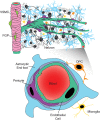Bridging barriers: a comparative look at the blood-brain barrier across organisms
- PMID: 29692355
- PMCID: PMC5959231
- DOI: 10.1101/gad.309823.117
Bridging barriers: a comparative look at the blood-brain barrier across organisms
Abstract
The blood-brain barrier (BBB) restricts free access of molecules between the blood and the brain and is essential for regulating the neural microenvironment. Here, we describe how the BBB was initially characterized and how the current field evaluates barrier properties. We next detail the cellular nature of the BBB and discuss both the conservation and variation of BBB function across taxa. Finally, we examine our current understanding of mouse and zebrafish model systems, as we expect that comparison of the BBB across organisms will provide insight into the human BBB under normal physiological conditions and in neurological diseases.
Keywords: blood–brain barrier; evolution; mouse; zebrafish.
© 2018 O'Brown et al.; Published by Cold Spring Harbor Laboratory Press.
Figures


References
-
- Abbott NJ, Rönnbäck L, Hansson E. 2006. Astrocyte–endothelial interactions at the blood–brain barrier. Nat Rev Neurosci 7: 41–53. - PubMed
-
- Alvarez JI, Dodelet-Devillers A, Kebir H, Ifergan I, Fabre PJ, Terouz S, Sabbagh M, Wosik K, Bourbonnière L, Bernard M, et al. 2011. The Hedgehog pathway promotes blood–brain barrier integrity and CNS immune quiescence. Science 334: 1727–1731. - PubMed
Publication types
MeSH terms
Grants and funding
LinkOut - more resources
Full Text Sources
Other Literature Sources
